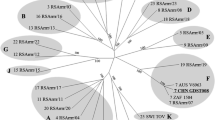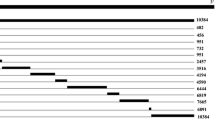Abstract
Here, we report the complete genome sequences of epizootic hemorrhagic disease (EHD) virus serotypes 5 (EHDV-5) and 6 (EHDV-6) isolated in the Yaeyama Islands of Okinawa Prefecture, Japan. The EHDV-5 strain, ON-11/E/16, which was isolated in 2016, is, to our knowledge, the second EHDV-5 strain to be isolated after the first was isolated in Australia in 1977. In each of the genome segments, ON-11/E/16 was most closely related to EHDV strains of different serotypes isolated in Australia and Japan. Our results support the idea that various serotypes of EHDV have been circulating while causing reassortment in the Asia-Pacific region. In all genome segments, the EHDV-6 strain, ON-3/E/14, which was isolated in 2014, was highly similar to EHDV-6 strain HG-1/E/15, which was detected in affected cattle during the EHD epidemic in Hyogo prefecture in 2015. Therefore, these two EHDV-6 strains, ON-3/E/14 and HG-1/E/15, may have the same origin. However, it is unclear whether EHDV-6 was transmitted directly between the locations where those strains were isolated/detected (approx. 1,500 km apart) or whether EHDV-6 strains of the same origin entered each location at different times. In addition, we cannot rule out the possibility that EHDV-6 infection has spread unnoticed through asymptomatic cattle in other areas of Japan. Therefore, further investigation into EHDV infection in cattle is necessary for a more detailed understanding of the ecology of EHDV in Japan.

Similar content being viewed by others
Data availability
The nucleotide sequence data reported herein have been deposited in the DNA Data Bank of Japan (DDBJ) under accession numbers LC552734−LC552754 and LC757713−LC757740.
References
Matthijnssens J, Attoui H, Bányai K, Brussaard CPD, Danthi P, Del Vas M, Dermody TS, Duncan R, Fāng Q, Johne R, Mertens PPC, Mohd Jaafar F, Patton JT, Sasaya T, Suzuki N, Wei T (2022) ICTV Virus Taxonomy Profile: Sedoreoviridae 2022. J Gen Virol 103:001782. https://doi.org/10.1099/jgv.0.001782
Maclachlan NJ, Zientara S, Savini G, Daniels PW (2015) Epizootic haemorrhagic disease. Rev Sci Tech 34:341–351. https://doi.org/10.20506/rst.34.2.2361
Savini G, Afonso A, Mellor P, Aradaib I, Yadin H, Sanaa M, Wilson W, Monaco F, Domingo M (2011) Epizootic haemorrhagic disease. Res Vet Sci 91:1–17. https://doi.org/10.1016/j.rvsc.2011.05.004
Kitano Y (2004) Ibaraki disease in cattle. In: Coetzer JAW, Tustin RC (eds) Infectious diseases of livestock, 2nd edn. Oxford University Press, Cape Town, pp 1221–1225
Omori T, Inaba Y, Morimoto T, Tanaka Y, Ishitani R (1969) Ibaraki virus, an agent of epizootic disease of cattle resembling bluetongue. I. Epidemiologic, clinical and pathologic observations and experimental transmission to calves. Jpn J Microbiol 13:139–157. https://doi.org/10.1111/j.1348-0421.1969.tb00447.x
Kamomae Y, Kamomae M, Ohta Y, Nabe M, Kagawa Y, Ogura Y, Kato T, Tanaka S, Yanase T, Shirafuji H (2018) Epizootic hemorrhagic disease virus serotype 6 infection in cattle, Japan, 2015. Emerg Infect Dis 24:902–905. https://doi.org/10.3201/eid2405.171859
Ohashi S, Yoshida K, Yanase T, Tsuda T (2002) Analysis of intratypic variation evident in an Ibaraki virus strain and its epizootic hemorrhagic disease virus serogroup. J Clin Microbiol 40:3684–3688. https://doi.org/10.1128/JCM.40.10.3684-3688.2002
Anthony SJ, Maan S, Maan N, Kgosana L, Bachanek-Bankowska K, Batten C, Darpel KE, Sutton G, Attoui H, Mertens PPC (2009) Genetic and phylogenetic analysis of the outer-coat proteins VP2 and VP5 of epizootic haemorrhagic disease virus (EHDV): comparison of genetic and serological data to characterise the EHDV serogroup. Virus Res 145:200–210. https://doi.org/10.1016/j.virusres.2009.07.012
Shirafuji H, Kato T, Yamakawa M, Tanaka T, Minemori Y, Yanase T (2017) Characterization of genome segments 2, 3 and 6 of epizootic hemorrhagic disease virus strains isolated in Japan in 1985–2013: identification of their serotypes and geographical genetic types. Infect Genet Evol 53:38–46. https://doi.org/10.1016/j.meegid.2017.05.010
Yang H, Li Z, Wang J, Li Z, Yang Z, Liao D, Zhu J, Li H (2020) Novel serotype of epizootic hemorrhagic disease virus, China. Emerg Infect Dis 26:3081–3083. https://doi.org/10.3201/eid2612.191301
Kato T, Yanase T, Suzuki M, Katagiri Y, Ikemiyagi K, Takayoshi K, Shirafuji H, Ohashi S, Yoshida K, Yamakawa M, Tsuda T (2016) Monitoring for bovine arboviruses in the most southwestern islands in Japan between 1994 and 2014. BMC Vet Res 12:125. https://doi.org/10.1186/s12917-016-0747-z
Murota K, Ishii K, Mekaru Y, Araki M, Suda Y, Shirafuji H, Kobayashi D, Isawa H, Yanase T (2021) Isolation of Culicoides- and mosquito-borne orbiviruses in the southwestern islands of Japan between 2014 and 2019. Vector Borne Zoonotic Dis 21:796–808. https://doi.org/10.1089/vbz.2021.0001
Maan S, Rao S, Maan NS, Anthony SJ, Attoui H, Samuel AR, Mertens PP (2007) Rapid cDNA synthesis and sequencing techniques for the genetic study of bluetongue and other dsRNA viruses. J Virol Methods 143:132–139. https://doi.org/10.1016/j.jviromet.2007.02.016
Thompson JD, Higgins DG, Gibson TJ (1994) CLUSTAL W: improving the sensitivity of progressive multiple sequence alignment through sequence weighting, position-specific gap penalties and weight matrix choice. Nucleic Acids Res 22:4673–4680. https://doi.org/10.1093/nar/22.22.4673
Kumar S, Stecher G, Li M, Knyaz C, Tamura K (2018) MEGA X: molecular evolutionary genetics analysis across computing platforms. Mol Biol Evol 35:1547–1549. https://doi.org/10.1093/molbev/msy096
Tamura K, Nei M (1993) Estimation of the number of nucleotide substitutions in the control region of mitochondrial DNA in humans and chimpanzees. Mol Biol Evol 10:512–526. https://doi.org/10.1093/oxfordjournals.molbev.a040023
Anthony SJ, Maan N, Maan S, Sutton G, Attoui H, Mertens PPC (2009) Genetic and phylogenetic analysis of the core proteins VP1, VP3, VP4, VP6 and VP7 of epizootic haemorrhagic disease virus (EHDV). Virus Res 145:187–199. https://doi.org/10.1016/j.virusres.2009.07.011
Anthony SJ, Maan N, Maan S, Sutton G, Attoui H, Mertens PPC (2009) Genetic and phylogenetic analysis of the non-structural proteins NS1, NS2 and NS3 of epizootic haemorrhagic disease virus (EHDV). Virus Res 145:211–219. https://doi.org/10.1016/j.virusres.2009.07.019
Duan Y, Yang Z, Zhu P, Xiao L, Li Z, Li Z, Li L (2022) A serologic investigation of epizootic hemorrhagic disease virus in China between 2014 and 2019. Virol Sin 37:513–520. https://doi.org/10.1016/j.virs.2022.06.005
Acknowledgements
This study was conducted under the Research Project on Regulatory Research Projects for Food Safety, Animal Health, and Plant Protection (JPJ008617.18065101) funded by the Ministry of Agriculture, Forestry and Fisheries of Japan (FY2018−2022). The authors would like to thank the veterinarians of Yaeyama Livestock Hygiene Service Center and Okinawa Prefectural Institute of Animal Health for collecting bovine blood samples.
Author information
Authors and Affiliations
Corresponding author
Ethics declarations
Conflict of interest
The authors have declared that no competing interests exist.
Ethical approval
This article does not contain any studies with human participants or animals performed by any of the authors.
Additional information
Handling Editor: Zhenhai Chen.
Publisher's Note
Springer Nature remains neutral with regard to jurisdictional claims in published maps and institutional affiliations.
Supplementary Information
Below is the link to the electronic supplementary material.
Rights and permissions
Springer Nature or its licensor (e.g. a society or other partner) holds exclusive rights to this article under a publishing agreement with the author(s) or other rightsholder(s); author self-archiving of the accepted manuscript version of this article is solely governed by the terms of such publishing agreement and applicable law.
About this article
Cite this article
Shirafuji, H., Murota, K., Kishida, N. et al. Complete genome sequences of epizootic hemorrhagic disease virus serotypes 5 and 6 isolated in Japan. Arch Virol 168, 230 (2023). https://doi.org/10.1007/s00705-023-05853-z
Received:
Accepted:
Published:
DOI: https://doi.org/10.1007/s00705-023-05853-z




